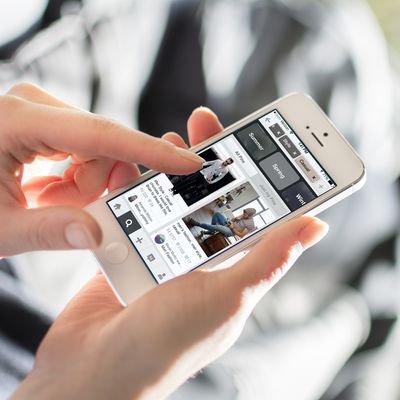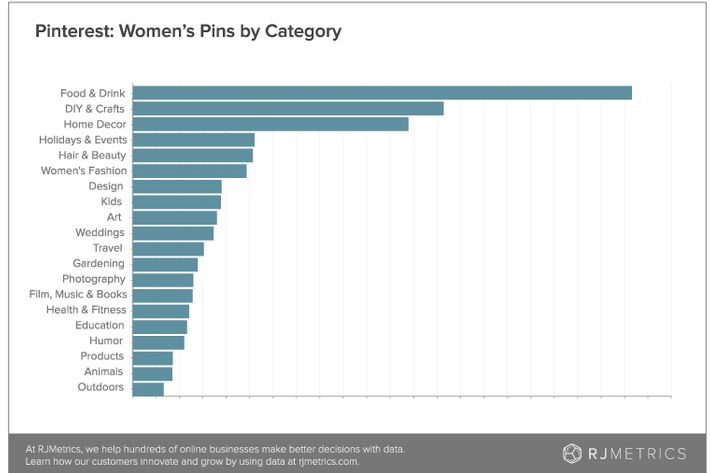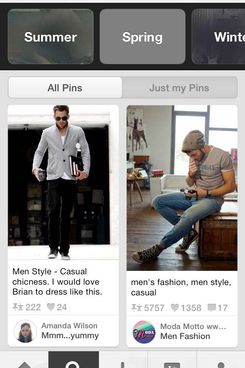
As social networks go, Pinterest doesn’t get a whole lot of respect.
You don’t see lengthy dissections of its news feed algorithms, worried hand-wringing about its future, or personal essays about the emotional solace it provides during times of trouble. Maybe this is because Pinterest’s user base is overwhelmingly female and largely lives between the coasts, far from the tech press’s purview. Or maybe it’s because its low-key CEO, Ben Silbermann, lacks the drama of a Mark Zuckerberg or a Jack Dorsey. Whatever the reason, when you do see Pinterest referred to in the media, it’s usually in the context of a glib remark about being “the social network of choice for cocktail recipes and succulent gardening.”
Which will make it even more surprising when Pinterest eats its competitors alive.
I’ve written before about why I think Pinterest is secretly sneaking up on the big social networks, and why it deserves to be taken much more seriously as a competitor by Facebook, Twitter, and even Google. But the case has gotten even more compelling. There are now more than 30 billion (with a B) pins on Pinterest, half of which have been added in the last six months, according to the company. Pinterest now drives more internet traffic to publishers than Twitter and Reddit combined. Just this week, the site rolled out its first paid ads, which included campaigns for Kraft, General Mills, Target, and many other big consumer brands, and had news leak of its latest round of funding, which values the company at $5 billion.
If you want to understand how Pinterest – a company that essentially had no revenue until this week – could possibly be worth $5 billion, start with the ads.
Imagine for a second that you’re a Fortune 500 marketing executive trying to dream up the perfect social network for selling stuff to people. Ideally, you’d want that social network to be filled with women between the ages of 19-39 (since women make an estimated 85 percent of all consumer purchases, and since 19-39 year olds comprise the fastest-growing consumer segment in America). You’d want the network to make it incredibly easy for its users to buy your products, with just one or two clicks. You’d want it to be image-centric and search-friendly. And, crucially, you’d want that social network to put people in a buying mood. You’d want it to be the place where people plan their weddings, pick out furniture for their homes, discover recipes for dinner parties, and plan their outfits. You’d want it to feel less like a social network than an interactive catalog, where users can browse and buy your products, and share the ones they like with their friends.
This perfect marketing machine you just designed already exists. It’s called Pinterest.
Pinterest’s users — mostly hyperengaged young women in their prime buying years — are the golden demographic for advertisers. According to Shopify, users referred by Pinterest are 10 percent more likely to make purchases on e-commerce sites than users of other social networks, and they tend to spend twice as much as users referred by Facebook. As the chart below shows, the biggest areas of interest among women on Pinterest are also some of the largest advertising categories: food and drink, fashion, home décor.

At their core, the difference between Pinterest and other social networks is why people use it — to plan for the future, rather than exhuming the past or analyzing the present. Robert J. Moore explains the phenomenon well:
It’s aspirational. People pin products they’d love to own, recipes they want to cook, and projects they want to tackle.
Given the way Pinterest members use the site, it’s not entirely surprising that the site is charging a hefty premium for “promoted pins,” as it’s calling its new ad product. In its initial phase, which began this week, Pinterest is reportedly asking brands for commitments between $1-2 million, with CPM rates between $30-40 for a promoted pin. (CPM, a standard ad-industry term, refers to the cost per thousand times an ad is seen.) For comparison’s sake, a Salesforce study last year estimated that Facebook’s most expensive kind of ad was selling for an average CPM of $6.27. In other words, Pinterest thinks its users are roughly five times as valuable as Facebook’s.
Malorie Lucich, a Pinterest spokeswoman, wouldn’t confirm the details of Pinterest’s new ad program. But she told me that “early feedback has been positive” from advertisers. Part of why advertisers are excited about Pinterest, Lucich said, is that Pinterest users don’t seem to view promoted pins any differently than regular, user-generated pins — a pinned photo of a pair of pants sponsored by Banana Republic, for example, generates about as many click-throughs as a photo of a pair of pants posted by your best friend.
“Users don’t really look at them as ads,” she said.
This ad program is part of how Pinterest plans to steal eyeballs (and dollars) from other social networks. The other part is search.
Pinterest just introduced a tool for its mobile app called “guided search,” which, is essentially a fusion of Facebook’s Graph Search and Google Images. Type in a search term, and Pinterest will pull up suggested categories to refine your search further. It does this using the metadata associated with the images its users post, and the idea is to give users a way to hone in on what they’re looking for. (Search for “Men’s Style,” for example, and categories like “Summer,” “Casual,” “Rugged,” and “Vintage” appear. Click on one of those, and you get even more subcategories, until you find exactly the pair of seersucker shorts you’re looking for.)

Guided search isn’t revolutionary yet. (And some of the bugs are still being worked out — when I searched for “Stonehenge,” for example, one of the categories Pinterest showed me was “Tattoo” — not exactly the first thing I’d think was related to a prehistoric British monument.) But it could become something really interesting down the line. Lucich told me that Pinterest has at least two engineers working on visual search, a tool that would allow users to search for visually similar images using color and shape data, rather than simply searching the text associated with those images. (The idea is that you’d click on, say, a pair of tan shoes, and be shown photos of other tan shoes, no matter whether they’re on the feet of a celebrity or sitting on a store shelf.) The ability to search images effectively could, as ReadWrite notes, give Pinterest a “unique role in a trend we call the Visual Web—the shift of Web consumption, creation, and commerce from text to images.”
Pinterest still has a ways to go if it wants to overtake Google and Facebook. As Jeff Bercovici notes, men aren’t coming to Pinterest in large numbers, and the site still doesn’t have anything close to Facebook’s 1. 3 billion monthly active users. (Pinterest’s numbers aren’t public, but most third-party studies peg it at about 40 million monthly active users.) As it grows, especially overseas, Pinterest will have to prove that it can raise that number and keep its users coming back.
But Pinterest can succeed without ever reaching a billion users, because the product it’s selling isn’t really size. It’s buying power. At its core, Pinterest is more like a consumerist search engine — a ready-made way for people to aspire to certain lifestyles, and to find the products that will bring them closer to those ideals — than a social network.
Pinterest’s growth should scare the hell out of Facebook, Twitter, Google, and every other company that will have to compete with it for the marketing budgets of big companies. And it should make the rest of us pay much more attention to what’s going on over there. Pinterest might not be your social network of choice, but it’s an advertiser’s dream — and that may end up mattering more.





























